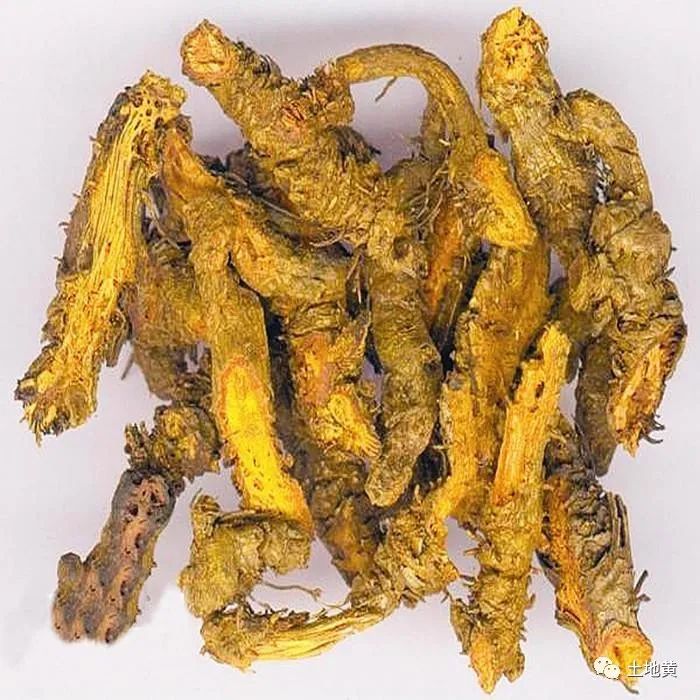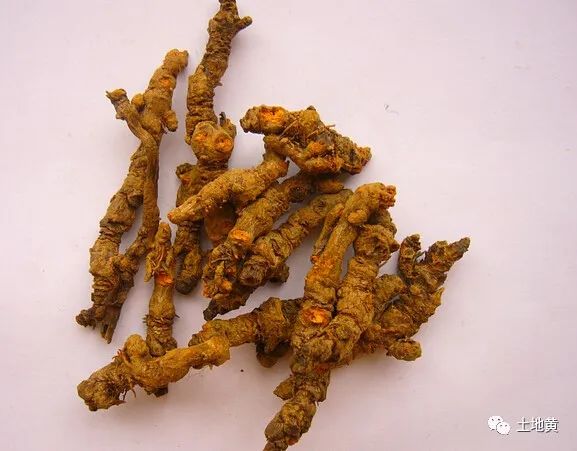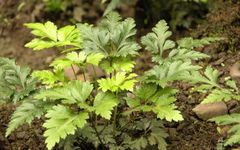Huanglian
“Shennong Bencao Jing”
Huanglian
COPTIDIS RHIZOMA
1. Source
This herb is the dried rhizome of the Ranunculaceae plant Huanglian, Coptis chinensis Franch., Coptis deltoidea C.Y.Cheng et Hsiao, or Coptis teeta Wall.
2. Aliases
Yunlian, Yalian, Chuanlian, Weilian, Jizhuolian.
3. Images





4. Main Producing Areas
Weilian and Yalian are mainly produced in Sichuan and Hubei. Yunlian is mainly produced in Yunnan.
5. Plant Morphology
Perennial herb, 15 to 25 cm tall. The rhizome is yellow, often branched, densely covered with fibrous roots. Leaves are basal, petiole 6 to 16 cm long, glabrous; leaf blade slightly leathery, ovate-triangular, up to 10 cm wide, 3-lobed; the central lobe is somewhat rhombic, with a long petiole of 1 to 1.8 cm, lobes further deeply divided, with 4 to 5 pairs of lobes, nearly oblong, acute at the tip, spaced 2 to 6 mm apart, with needle-like serrations on the edges; lateral lobes are obliquely ovate, shorter than the central lobe, unevenly 2-lobed or rarely 2-lobed, lobes often further deeply divided; the upper surface along the veins is covered with short soft hairs, the underside is glabrous. Flower stalks 1 to 2, equal to or longer than the leaves; dichotomous or multi-branched umbel, with 3 to 8 flowers; bracts lanceolate, 3 to 5 deeply lobed; sepals 5, yellow-green, elongated oval to lanceolate, 9 to 12.5 mm long, 2 to 3 mm wide; petals linear or linear-lanceolate, 5 to 6.5 mm long, pointed at the tip, with a nectar groove in the center; numerous stamens, the outer whorl slightly shorter or nearly equal in length to the petals, anthers broadly oval, yellow; carpels 8 to 12. Capsules 6 to 12, with stalks, 6 to 7 mm long. Seeds 7 to 8, elongated oval, about 2 mm long, brown. Flowering period is from February to April. Fruiting period is from March to June.
6. Medicinal Properties
Weilian often clusters, commonly bent, resembling chicken feet, single rhizome 3 to 6 cm long, diameter 0.3 to 0.8 cm. Surface gray-yellow or yellow-brown, rough, with irregular nodular protrusions, fibrous roots and remnants of fibrous roots, some internodes smooth like stems, commonly referred to as “crossing the bridge.” The upper part often retains brown scale leaves, with remnants of stems or petioles at the tip. Hard texture, uneven fracture surface, orange-red or dark brown cortex, fresh yellow or orange-yellow wood, arranged radially, with some hollow pith. Slight odor, extremely bitter taste.
7. Harvesting, Processing, and Preparation
Harvest in autumn, remove fibrous roots and soil, dry, and remove residual fibrous roots.
Preparation Methods
1. Huanglian: Take the raw herb, remove impurities, wash thoroughly, cut into thin slices, and dry. The raw product is commonly used to clear heart fire and resolve heat toxins.
2. Jiu Huanglian: Take Huanglian slices, mix with yellow wine, moisten until translucent, place in a pot, heat gently, and stir-fry until dry, then cool. Jiu Huanglian is commonly used to clear fire from the upper jiao and eyes.
3. Jiang Huanglian: Take Huanglian slices, mix with ginger juice, moisten until translucent, place in a pot, heat gently, and stir-fry until dry, then cool. Jiang Huanglian clears fire from the middle jiao and is effective for gastric heat and vomiting.
4. Yu Huanglian: Take Wuzhuyu, add appropriate amount of water, boil for 30 minutes, remove dregs, mix with Huanglian slices, moisten until the medicinal juice is absorbed, then place in a pot, heat gently, and stir-fry until dry, then cool. Yu Huanglian can clear damp-heat from the qi level and disperse liver and gallbladder fire.
5. Chao Huanglian: Take Huanglian slices, place in a pot, heat gently, stir-fry until dark yellow, then cool. Chao Huanglian has a milder cold nature and is less likely to harm spleen yang.
8. Medicinal Slice Properties
1. Huanglian: Irregular thin slices, surface brown-yellow or yellow, golden-yellow wood with radial texture; edges dark yellow, rough, with small fibrous roots. Hard texture, slight odor, extremely bitter taste.
2. Jiu Huanglian: Similar in shape to Huanglian, color deepened, with a slight wine aroma.
3. Jiang Huanglian: Similar in shape to Huanglian, brown-yellow, with a slight spicy aroma of ginger.
4. Yu Huanglian: Similar in shape to Huanglian, color deepened, with a spicy aroma of Wuzhuyu.
5. Chao Huanglian: Similar in shape to Huanglian, brown-yellow in color.
9. Pharmacological Properties
Bitter, cold. It enters the heart, spleen, stomach, liver, gallbladder, and large intestine meridians.
10. Effects
Clears heat, dries dampness, drains fire, and detoxifies.
11. Applications
1. Damp-heat distension, vomiting, diarrhea;2. High fever and delirium, excessive heart fire, irritability and insomnia, palpitations;3. Blood heat with vomiting or nosebleeds;4. Gastric heat with vomiting, acid regurgitation, thirst, and dental pain due to stomach fire;5. Carbuncles, boils, red and swollen eyes, mouth sores;6. Eczema, boils, and ear discharge.
12. Common Formulas
Bai Tou Weng Tang (“Shang Han Lun”), Xiang Lian Wan (“Bing Bu Shou Ji Fang”), Ge Gen Qin Lian Tang (“Shang Han Lun”), Lian Pi Yin (“Huo Luan Lun”), Ban Xia Xie Xin Tang (“Shang Han Lun”), Huang Lian Jie Du Tang (“Wai Ke Zheng Zong”), Huang Lian An Shen Wan (“Ren Zhai Zhi Zhi Fang”), Huang Lian E Jiao Tang (“Shang Han Lun”), Jiao Tai Wan (“Si Ke Jian Xiao Fang”), Xie Xin Tang (“Jin Kui Yao Lue”), Huang Lian Ju Pi Zhu Ru Tang (“Shi Re Jing Wei”), Zuo Jin Wan (“Dan Xi Xin Fa”), Qing Wei San (“Lan Shi Mi Cang”), Huang Lian Jie Du Tang (“Wai Tai Mi Yao”).
13. Medicinal Cuisine
1. Huanglian Bai Tou Weng Congee
(1) Effects: Clears heat and detoxifies, cools the blood. Specifically treats toxic dysentery and related symptoms.
(2) Ingredients: Chuan Huanglian 10 g, Bai Tou Weng 5 g, japonica rice 30 g.
(3) Method: Wash Huanglian and Bai Tou Weng, place in a clay pot, decoct in water. Remove dregs to obtain the juice. In another pot, add 400 ml of water, boil until the rice blooms, add the medicinal juice, and cook into congee, ready to eat.
(4) Usage: Take 3 times daily, warm.
2. Huanglian E Jiao Egg Yolk Soup
(1) Effects: Clears heat and nourishes yin. Suitable for heat evil entering the nutrient level, damaging nutrient yin heart fluid. Persistent fever, irritability, inability to lie down, red and dry tongue, thin rapid pulse.
(2) Ingredients: Egg yolk, Huanglian 12 g, Huangqin 3 g, E Jiao 9 g, Bai Shao 3 g.
(3) Method: Wash Huanglian, Huangqin, E Jiao, Bai Shao separately, except for E Jiao, place the other herbs in a pot, first boil Huanglian, Huangqin, Bai Shao, add 8 cups of water and decoct until 3 cups remain, remove dregs, add E Jiao to dissolve, then add egg yolk, stir well, and cook until done.
(4) Usage: Take in 3 divided doses daily.
3. Huanglian Licorice Juice
(1) Effects: Clears heat, dries dampness, detoxifies, and kills parasites. Treats whooping cough, fiery eyes, mouth sores, heat diarrhea, pulmonary tuberculosis, sore throat, cough, and related symptoms.
(2) Ingredients: Huanglian 5 g, Licorice 5 g, appropriate amount of sugar.
(3) Method: Wash Huanglian and Licorice, place them in a steamer with an appropriate amount of water, steam for about 5 minutes. Pour the juice into a cup, add sugar water, stir well, and drink when slightly cool.
(4) Usage: Take 3 times daily, warm.
14. Dosage and Administration
Internal use: Decoction, 2-5 g. External use: appropriate amount.
Adverse Reactions
1. Reports indicate the following toxic side effects: acute cardiogenic hypoxic encephalopathy, allergic shock, measles-like drug rash, and urticaria, which may present with dizziness, tinnitus, nausea, vomiting, palpitations, shortness of breath, joint pain, diarrhea, bloating, intestinal sounds, polyuria, hemoglobin, and blood cell reduction.
2. Berberine has very low toxicity when taken orally; however, at higher doses via parenteral administration, it can enhance respiration and then gradually weaken, with convulsions occurring before death.
3. The cause of death from berberine is often due to respiratory paralysis; it also has significant inhibitory effects on the heart.
4. There have been reports of allergic reactions from intramuscular injection of berberine and cardiac suppression from excessive intravenous infusion of berberine, leading to cardiogenic hypoxic death.
5. General methods for detoxification include: for allergic symptoms, provide anti-allergic treatment, such as oral diphenhydramine 4 mg, 3 times daily, or intramuscular injection of promethazine 25-50 mg; for cardiogenic hypoxic encephalopathy or allergic shock, provide cardiotonic, oxygen, hormones, acupuncture, and other emergency treatments.
Contraindications
Contraindications for Combination with Western Medicine:
(1) Can reduce the activity of trypsin and pepsin, not suitable for concurrent use.
(2) Injection solutions are extremely unstable when combined with penicillin, not suitable for concurrent use.
(3) Berberine is a strongly alkaline alkaloid, which can precipitate with various acidic drugs, not suitable for injection combinations.
(4) Lisinopril can inhibit the hypotensive effect of Huanglian, not suitable for concurrent use.
(5) Propranolol hydrochloride can significantly inhibit the hypotensive effect of Huanglian, not suitable for concurrent use.
(6) Not suitable for concurrent use with digoxin, as it can lead to increased serum digoxin concentration and potential digoxin toxicity.
(7) Not suitable for concurrent use with alkaloid drugs such as atropine, aminophylline, caffeine, etc., as it can increase drug toxicity and lead to drug poisoning.
(8) Not suitable for concurrent use with strong alkaline Western medicines such as iodine ion preparations, sodium bicarbonate, and heavy metal drugs like ferrous sulfate, magnesium sulfate, aluminum hydroxide.
Dietary Contraindications: Avoid pork and cold water.
Precautions
This herb is very cold; excessive long-term use can harm the spleen and stomach. Those with spleen and stomach deficiency and cold should avoid use. Bitter and dry can easily harm yin fluids; those with yin deficiency and fluid damage should use with caution.
15. Chemical Composition
This herb mainly contains berberine, coptisine, palmatine, berberastine, jatrorrhizine, and other isoquinoline alkaloids.
It also contains berberine ketone, berberine lactone, ferulic acid, chlorogenic acid, etc.
According to the “Chinese Pharmacopoeia,” this herb is quantified by the content of berberine hydrochloride, with Weilian containing not less than 5.5% berberine (C20H17NO4), not less than 0.80% coptisine (C20H7NO), not less than 1.6% palmatine (C19H13NO4), and not less than 1.5% berberastine (C21H21NO4); Yalian contains not less than 4.5% berberine hydrochloride (C20H18ClNO4); Yunlian contains not less than 7.0% berberine hydrochloride (C20H18ClNO4); Weilian slices contain not less than 5.0% berberine (C20H7NO), coptisine (C20H7NO), palmatine (C19H13NO4), and berberastine (C21H21NO4) with a total content of not less than 3.3%.
16. Pharmacological Effects
This herb has strong antibacterial effects against Staphylococcus, Streptococcus, Pneumococcus, Vibrio cholerae, Bacillus anthracis, and all dysentery bacilli except Shigella sonnei; it also has antibacterial effects against Pneumobacillus, Diphtheria bacillus, Bacillus subtilis, Bordetella pertussis, Yersinia pestis, Brucella, and Mycobacterium tuberculosis; it has poor effects against Escherichia coli, Proteus, and Salmonella. Berberine at low doses can stimulate the heart, enhance its contractility, and increase coronary blood flow; at high doses, it inhibits the heart and weakens its contraction; berberine can reduce the heart rate in toads, and has stimulating effects on isolated atria of rabbits, guinea pigs, and rats, with antiarrhythmic effects, promotes bile secretion, inhibits gastric secretion, and has antidiarrheal effects; at low doses, it enhances the excitatory process in the cerebral cortex of mice, while at high doses, it enhances the inhibitory process, has anti-acute inflammation, anti-cancer, and inhibits tissue metabolism; berberine and tetrahydroberberine can reduce myocardial oxygen consumption; Huanglian and its extracted components have anti-ulcer effects.


